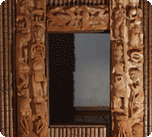
 |
|
| The Baham museum | |
| Permanent exhibition | |
| Information | |
Architecture
The Baham people skilfully built several types of building with shapes depending on their purpose, the social rank of the individual or collective owner and the nature of the decoration. The traditional classic house includes four walls made from raffia forming a sort of parallelepiped with a square base and surmounted by a pyramidal or conical thatched straw roof (nowadays especially sheet metal). Walls, structures and ceiling were pre-fabricated on the ground before being raised and put together according to an original technique dating from before the foundation of the kingdom.

![]() Pa’ baingne, old house made from wood and earth
Pa’ baingne, old house made from wood and earth
Depuis la première moitié du XXe siècle, il y a une importante transformation de l’architecture autochtone. Ainsi les maisons dites traditionnelles ont-elles progressivement cédé la place à des maisons « modernes » en béton ou à des édifices alliant éléments modernes et éléments traditionnels.
Since the first half of the 20 th century, autochthonous architecture has undergone major transformation. The traditional houses have gradually been replaced by modern houses built in concrete or buildings combining modern and traditional elements. Special importance is given to four categories of construction: the large hut or royal palace; the house of the notable chang; the entrance hut ko’; the small doorless hut tho’ (the home of all the mythical powers and magical forces of the kingdom or of the place). In Baham as throughout the Grassland, sculpture is closely linked with architecture. This is illustrated by doorframes and the sculpted pillars that decorate the royal buildings, the houses of the greatest notables and the secret societies. They can be engraved, sculpted in bas-relief, in haut-relief and in certain cases they are cut out with varying degrees of openwork. The nature of the decoration and the number of pillars and doors making up a building depend on the social role of the individual and group that own the premises. Baham artists have been reputed in the region for these works. |
 |
|
|
|
|
[ Top page ]
| Home | The four museums | The project | Baham museum | Bandjoun museum | Mankon museum | Babungo museum |
| baham@museumcam.org | Copyright 2005 C.O.E. | Powered by SYNUS |








